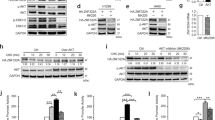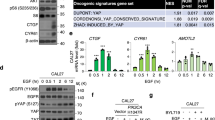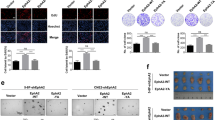Abstract
Emerging evidence indicates that Nanog is intimately involved in tumorigenesis, in part, through regulation of the cancer-initiating cell (CIC) population. However, the regulation and role of Nanog in tumorigenesis are still poorly understood. In this study, human Nanog was identified to be phosphorylated by human protein kinase Cɛ at multiple residues, including T200 and T280. Our work indicated that phosphorylation at T200 and T280 modulates Nanog function through several regulatory mechanisms. Results with phosphorylation-insensitive and phosphorylation-mimetic mutant Nanog revealed that phosphorylation at T200 and T280 enhance Nanog protein stability. Moreover, phosphorylation-insensitive T200A and T280A mutant Nanog had a dominant-negative function to inhibit endogenous Nanog transcriptional activity. Inactivation of Nanog was due to impaired homodimerization, DNA binding, promoter occupancy and p300, a transcriptional co-activator, recruitment resulting in a defect in target gene-promoter activation. Ectopic expression of phosphorylation-insensitive T200A or T280A mutant Nanog reduced cell proliferation, colony formation, invasion, migration and the CIC population in head and neck squamous cell carcinoma (HNSCC) cells. The in vivo cancer-initiating ability was severely compromised in HNSCC cells expressing phosphorylation-insensitive T200A or T280A mutant Nanog; 87.5% (14/16), 12.5% (1/8), and 0% (0/8) for control, T200A, and T280A, respectively. Nanog occupied the Bmi1 promoter to directly transactivate and regulate Bmi1. Genetic ablation and rescue experiments demonstrated that Bmi1 is a critical downstream signaling node for the pleiotropic, pro-oncogenic effects of Nanog. Taken together, our study revealed, for the first time, that post-translational phosphorylation of Nanog is essential to regulate Bmi1 and promote tumorigenesis.
This is a preview of subscription content, access via your institution
Access options
Subscribe to this journal
Receive 50 print issues and online access
$259.00 per year
only $5.18 per issue
Buy this article
- Purchase on Springer Link
- Instant access to full article PDF
Prices may be subject to local taxes which are calculated during checkout







Similar content being viewed by others
References
Niwa H, Miyazaki J, Smith AG . Quantitative expression of Oct-3/4 defines differentiation, dedifferentiation or self-renewal of ES cells. Nat Genet 2000; 24: 372–376.
Mitsui K, Tokuzawa Y, Itoh H, Segawa K, Murakami M, Takahashi K et al. The homeoprotein Nanog is required for maintenance of pluripotency in mouse epiblast and ES cells. Cell 2003; 113: 631–642.
Masui S, Nakatake Y, Toyooka Y, Shimosato D, Yagi R, Takahashi K et al. Pluripotency governed by Sox2 via regulation of Oct3/4 expression in mouse embryonic stem cells. Nat Cell Biol 2007; 9: 625–635.
Torres J, Watt FM . Nanog maintains pluripotency of mouse embryonic stem cells by inhibiting NFkappaB and cooperating with Stat3. Nat Cell Biol 2008; 10: 194–201.
Zhang P, Andrianakos R, Yang Y, Liu C, Lu W . Kruppel-like factor 4 (Klf4) prevents embryonic stem (ES) cell differentiation by regulating Nanog gene expression. J Biol Chem 2010; 285: 9180–9189.
Yu CC, Chen YW, Chiou GY, Tsai LL, Huang PI, Chang CY et al. MicroRNA let-7a represses chemoresistance and tumourigenicity in head and neck cancer via stem-like properties ablation. Oral Oncol 2011; 47: 202–210.
Chiou SH, Yu CC, Huang CY, Lin SC, Liu CJ, Tsai TH et al. Positive correlations of Oct-4 and Nanog in oral cancer stem-like cells and high-grade oral squamous cell carcinoma. Clin Cancer Res 2008; 14: 4085–4095.
Han J, Zhang F, Yu M, Zhao P, Ji W, Zhang H et al. RNA interference-mediated silencing of NANOG reduces cell proliferation and induces G0/G1 cell cycle arrest in breast cancer cells. Cancer Lett 2012; 321: 80–88.
Chiou SH, Wang ML, Chou YT, Chen CJ, Hong CF, Hsieh WJ et al. Coexpression of Oct4 and Nanog enhances malignancy in lung adenocarcinoma by inducing cancer stem cell-like properties and epithelial-mesenchymal transdifferentiation. Cancer Res 2010; 70: 10433–10444.
Meng HM, Zheng P, Wang XY, Liu C, Sui HM, Wu SJ et al. Overexpression of nanog predicts tumor progression and poor prognosis in colorectal cancer. Cancer Biol Ther 2010; 9: 295–302.
Jeter CR, Badeaux M, Choy G, Chandra D, Patrawala L, Liu C et al. Functional evidence that the self-renewal gene NANOG regulates human tumor development. Stem Cells 2009; 27: 993–1005.
Zbinden M, Duquet A, Lorente-Trigos A, Ngwabyt SN, Borges I, Ruiz i Altaba A . NANOG regulates glioma stem cells and is essential in vivo acting in a cross-functional network with GLI1 and p53. EMBO J 2010; 29: 2659–2674.
Tsai LL, Yu CC, Chang YC, Yu CH, Chou MY . Markedly increased Oct4 and Nanog expression correlates with cisplatin resistance in oral squamous cell carcinoma. J Oral Pathol Med 2011; 40: 621–628.
Germann M, Wetterwald A, Guzman-Ramirez N, van der Pluijm G, Culig Z, Cecchini MG et al. Stem-like cells with luminal progenitor phenotype survive castration in human prostate cancer. Stem Cells 2012; 30: 1076–1086.
Bourguignon LY, Earle C, Wong G, Spevak CC, Krueger K . Stem cell marker (Nanog) and Stat-3 signaling promote MicroRNA-21 expression and chemoresistance in hyaluronan/CD44-activated head and neck squamous cell carcinoma cells. Oncogene 2012; 31: 149–160.
Bourguignon LY, Spevak CC, Wong G, Xia W, Gilad E . Hyaluronan-CD44 interaction with protein kinase C(epsilon) promotes oncogenic signaling by the stem cell marker Nanog and the production of microRNA-21, leading to down-regulation of the tumor suppressor protein PDCD4, anti-apoptosis, and chemotherapy resistance in breast tumor cells. J Biol Chem 2009; 284: 26533–26546.
Moretto-Zita M, Jin H, Shen Z, Zhao T, Briggs SP, Xu Y . Phosphorylation stabilizes Nanog by promoting its interaction with Pin1. Proc Natl Acad Sci USA 2010; 107: 13312–13317.
Ramakrishna S, Suresh B, Lim KH, Cha BH, Lee SH, Kim KS et al. PEST motif sequence regulating human NANOG for proteasomal degradation. Stem Cells Dev 2012; 20: 1511–1519.
Ho B, Olson G, Figel S, Gelman I, Cance WG, Golubovskaya VM . Nanog increases focal adhesion kinase (FAK) promoter activity and expression and directly binds to FAK protein to be phosphorylated. J Biol Chem 2012; 287: 18656–18673.
Mullin NP, Yates A, Rowe AJ, Nijmeijer B, Colby D, Barlow PN et al. The pluripotency rheostat Nanog functions as a dimer. Biochem J. 2008; 411: 227–231.
Wang J, Levasseur DN, Orkin SH . Requirement of Nanog dimerization for stem cell self-renewal and pluripotency. Proc Natl Acad Sci USA 2008; 105: 6326–6331.
Pan G, Pei D . The stem cell pluripotency factor NANOG activates transcription with two unusually potent subdomains at its C terminus. J Biol Chem 2005; 280: 1401–1407.
Do HJ, Lee WY, Lim HY, Oh JH, Kim DK, Kim JH et al. Two potent transactivation domains in the C-terminal region of human NANOG mediate transcriptional activation in human embryonic carcinoma cells. J Cell Biochem 2009; 106: 1079–1089.
Pan Q, Bao LW, Teknos TN, Merajver SD . Targeted disruption of protein kinase C epsilon reduces cell invasion and motility through inactivation of RhoA and RhoC GTPases in head and neck squamous cell carcinoma. Cancer Res 2006; 66: 9379–9384.
Chen X, Xu H, Yuan P, Fang F, Huss M, Vega VB et al. Integration of external signaling pathways with the core transcriptional network in embryonic stem cells. Cell 2008; 133: 1106–1117.
Das S, Jena S, Levasseur DN . Alternative splicing produces Nanog protein variants with different capacities for self-renewal and pluripotency in embryonic stem cells. J Biol Chem 2011; 286: 42690–42703.
Chang DF, Tsai SC, Wang XC, Xia P, Senadheera D, Lutzko C . Molecular characterization of the human NANOG protein. Stem Cells 2009; 27: 812–821.
Song LB, Zeng MS, Liao WT, Zhang L, Mo HY, Liu WL et al. Bmi-1 is a novel molecular marker of nasopharyngeal carcinoma progression and immortalizes primary human nasopharyngeal epithelial cells. Cancer Res 2006; 66: 6225–6232.
Vrzalikova K, Skarda J, Ehrmann J, Murray PG, Fridman E, Kopolovic J et al. Prognostic value of Bmi-1 oncoprotein expression in NSCLC patients: a tissue microarray study. J Cancer Res Clin Oncol 2008; 134: 1037–1042.
Vormittag L, Thurnher D, Geleff S, Pammer J, Heiduschka G, Brunner M et al. Co-expression of Bmi-1 and podoplanin predicts overall survival in patients with squamous cell carcinoma of the head and neck treated with radio (chemo)therapy. Int J Radiat Oncol Biol Phys 2009; 73: 913–918.
Hayry V, Makinen LK, Atula T, Sariola H, Makitie A, Leivo I et al. Bmi-1 expression predicts prognosis in squamous cell carcinoma of the tongue. Br J Cancer 2010; 102: 892–897.
Li J, Gong LY, Song LB, Jiang LL, Liu LP, Wu J et al. Oncoprotein Bmi-1 renders apoptotic resistance to glioma cells through activation of the IKK-nuclear factor-kappaB Pathway. Am J Pathol 2010; 176: 699–709.
Glinsky GV, Berezovska O, Glinskii AB . Microarray analysis identifies a death-from-cancer signature predicting therapy failure in patients with multiple types of cancer. J Clin Invest 2005; 115: 1503–1521.
Leung C, Lingbeek M, Shakhova O, Liu J, Tanger E, Saremaslani P et al. Bmi1 is essential for cerebellar development and is overexpressed in human medulloblastomas. Nature 2004; 428: 337–341.
Prince ME, Sivanandan R, Kaczorowski A, Wolf GT, Kaplan MJ, Dalerba P et al. Identification of a subpopulation of cells with cancer stem cell properties in head and neck squamous cell carcinoma. Proc Natl Acad Sci USA 2007; 104: 973–978.
Chiba T, Miyagi S, Saraya A, Aoki R, Seki A, Morita Y et al. The polycomb gene product BMI1 contributes to the maintenance of tumor-initiating side population cells in hepatocellular carcinoma. Cancer Res 2008; 68: 7742–7749.
Lukacs RU, Memarzadeh S, Wu H, Witte ON . Bmi-1 is a crucial regulator of prostate stem cell self-renewal and malignant transformation. Cell Stem Cell 2010; 7: 682–693.
Yang MH, Hsu DS, Wang HW, Wang HJ, Lan HY, Yang WH et al. Bmi1 is essential in Twist1-induced epithelial-mesenchymal transition. Nat Cell Biol 2010; 12: 982–992.
Yang WH, Lan HY, Huang CH, Tai SK, Tzeng CH, Kao SY et al. RAC1 activation mediates Twist1-induced cancer cell migration. Nat Cell Biol 2012; 14: 366–374.
Lavial F, Bessonnard S, Ohnishi Y, Tsumura A, Chandrashekran A, Fenwick MA et al. Bmi1 facilitates primitive endoderm formation by stabilizing Gata6 during early mouse development. Genes Dev 2012; 26: 1445–1458.
Liu A, Feng B, Gu W, Cheng X, Tong T, Zhang H et al. The CD133+ subpopulation of the SW982 human synovial sarcoma cell line exhibits cancer stem-like characteristics. Int J Oncol 2013; 42: 1399–1407.
Zhang Y, Wang Z, Yu J, Shi J, Wang C, Fu W et al. Cancer stem-like cells contribute to cisplatin resistance and progression in bladder cancer. Cancer Lett 2012; 322: 70–77.
Choijamts B, Jimi S, Kondo T, Naganuma Y, Matsumoto T, Kuroki M et al. CD133+ cancer stem cell-like cells derived from uterine carcinosarcoma (malignant mixed Mullerian tumor). Stem Cells 2011; 29: 1485–1495.
Niggeweg R, Kocher T, Gentzel M, Buscaino A, Taipale M, Akhtar A et al. A general precursor ion-like scanning mode on quadrupole-TOF instruments compatible with chromatographic separation. Proteomics 2006; 6: 41–53.
Steen H, Kuster B, Fernandez M, Pandey A, Mann M . Detection of tyrosine phosphorylated peptides by precursor ion scanning quadrupole TOF mass spectrometry in positive ion mode. Anal Chem 2001; 73: 1440–1448.
Acknowledgements
This work was supported, in part, by the National Cancer Institute at the National Institutes of Health (R01CA135096); American Cancer Society (RSG0821901); The Michelle Theado Memorial Grant from The Joan Bisesi Fund for Head and Neck Oncology Research; The Sloman Foundation; and Arthur G. James Cancer Hospital and Richard J. Solove Research Institute, The Ohio State University Comprehensive Cancer Center.
Author information
Authors and Affiliations
Corresponding author
Ethics declarations
Competing interests
The authors declare no conflict of interest.
Additional information
Supplementary Information accompanies this paper on the Oncogene website
Rights and permissions
About this article
Cite this article
Xie, X., Piao, L., Cavey, G. et al. Phosphorylation of Nanog is essential to regulate Bmi1 and promote tumorigenesis. Oncogene 33, 2040–2052 (2014). https://doi.org/10.1038/onc.2013.173
Received:
Revised:
Accepted:
Published:
Issue Date:
DOI: https://doi.org/10.1038/onc.2013.173
Keywords
This article is cited by
-
O-GlcNAcylation modulates Bmi-1 protein stability and potential oncogenic function in prostate cancer
Oncogene (2017)
-
The deubiquitinase USP21 maintains the stemness of mouse embryonic stem cells via stabilization of Nanog
Nature Communications (2016)
-
USP21 deubiquitylates Nanog to regulate protein stability and stem cell pluripotency
Signal Transduction and Targeted Therapy (2016)
-
Perspective: Cooperation of Nanog, NF-κΒ, and CXCR4 in a regulatory network for directed migration of cancer stem cells
Tumor Biology (2016)
-
The pluripotency factor NANOG promotes the formation of squamous cell carcinomas
Scientific Reports (2015)



